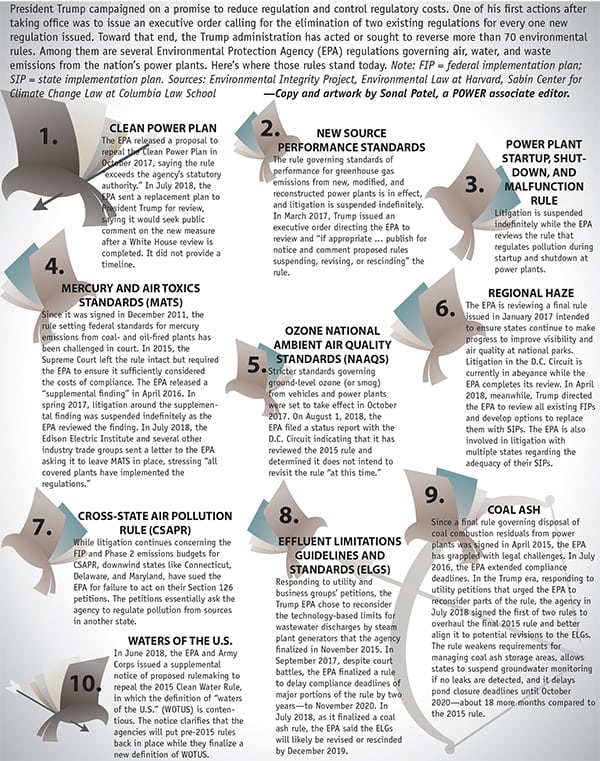Tag: PICTURE
THE BIG PICTURE [Infographic]: The LNG Trade Shakeup
The post THE BIG PICTURE [Infographic]: The LNG Trade Shakeup appeared first on POWER Magazine.

In 2019, global liquefied natural gas (LNG) imports reached 482 billion cubic meters, up 13% from 2018, accord- ing to BloombergNEF figures cited in the International Gas Union’s August–released Global Gas Report 2020. Last year, the world also saw a definitive shakeup in rankings of importers and exporters.
Compared to 2018, LNG imports by Japan and South Korea each fell 7%, while China imported 14% more LNG, taking South Korea’s spot as the world’s second-largest LNG importer. Europe, notably, also imported 76% more LNG than in 2018, reaching a record 117 billion cubic meters in 2019. Qatar retained the top export spot in 2019, but its share in the global supply market is now nearly tied with Australia’s. Whether these rankings will endure over 2020 remains uncertain owing to the COVID-19 pandemic, which widely dampened LNG trade.
Source: Global Gas Report 2020, BloombergNEF / International Gas Union / Snam 2020
Click on graphic or here for a larger version

—Sonal Patel, POWER senior associate editor.…
THE BIG PICTURE: Japan’s Nuclear Comeback
After the Great Tohoku Earthquake and tsunami, and ensuing crisis at the Fukushima Daiichi nuclear plant in March 2011, Japan issued stringent safety regulations and reviews that affected its entire 50-reactor fleet. It meant that as each Japanese nuclear reactor entered its scheduled maintenance and refueling outage, it could not returned to operation until restart was approved by both Japan’s Nuclear Regulation Authority (NRA) and the central government. Nuclear operators also need consent from governments of local prefectures.
Between September 2013—when Ohi 3 and 4 were shut down—and August 2015, when Sendai 1 and 2 restarted, Japan’s entire reactor fleet went black. In 2013, though there was no consensus on how long the approval process could take, some industry observers forecast reactors under NRA review could be back online within a year. As of December 2018, only nine reactors had restarted. Sixteen others were under review by the NRA, where average review duration stretched beyond 1,000 days, owing to staffing issues.…
THE BIG PICTURE: World’s Biggest Power Companies
In 2017, the 10 largest power companies, ranked by their installed generation capacity, owned 18% of total global installed capacity, while the next-largest 15 owned around 10%—meaning that the top 25 companies own nearly 30% of global installed power generation capacity, according to the International Energy Agency (IEA). Chinese companies account for more than one-eighth of global installed capacity, owing to that country’s expansion of its generation fleet
to 1,750 GW, from about 400 GW in 2003. By comparison, in 2003, European-owned utilities dominated the list, accounting for almost 13% of installed capacity worldwide. Source: © OECD/IEA 2018 World Energy Outlook.
—Copy and artwork by Sonal Patel, a POWER associate editor.

The post THE BIG PICTURE: World’s Biggest Power Companies appeared first on POWER Magazine.
THE BIG PICTURE: Trump’s Regulatory Targets
President Trump campaigned on a promise to reduce regulation and control regulatory costs. One of his first actions after taking office was to issue an executive order calling for the elimination of two existing regulations for every one new regulation issued. Toward that end, the Trump administration has acted or sought to reverse more than 70 environmental rules. Among them are several Environmental Protection Agency (EPA) regulations governing air, water, and waste emissions from the nation’s power plants. Here’s where those rules stand today. Notes: FIP = federal implementation plan; SIP = state implementation plan. Sources: Environmental Integrity Project, Environmental Law at Harvard, Sabin Center for Climate Change Law at Columbia Law School
1. Clean Power Plan
The EPA released a proposal to repeal the Clean Power Plan in October 2017, saying the rule “exceeds the agency’s statutory authority.” In July 2018, the EPA sent a replacement plan to President Trump for review, saying it would seek public comment on the new measure after a White House review is completed but it did not provide a timeline.…
